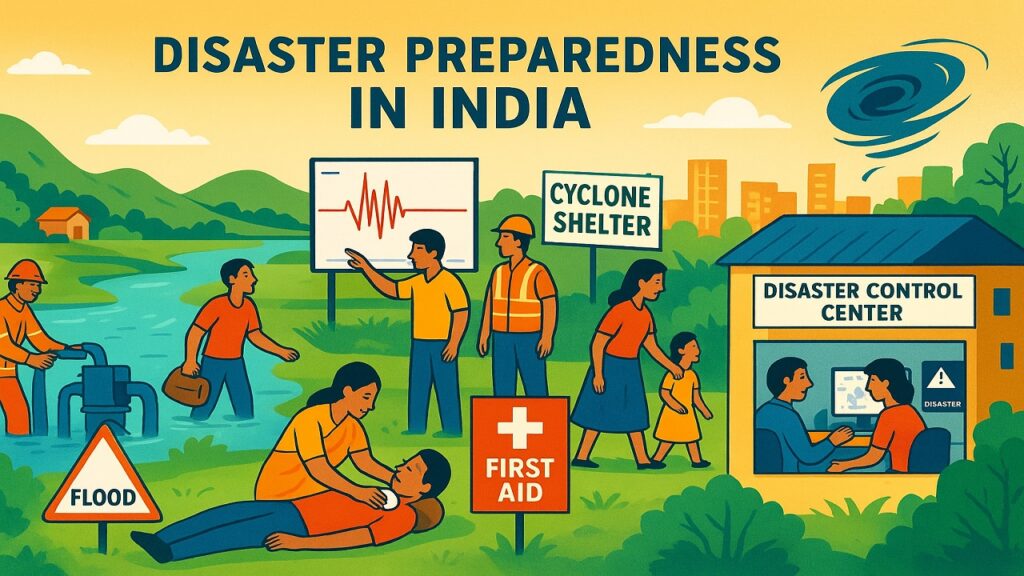Disaster Preparedness in India: Integrating Technology, Community, and Finance
Context:

India is actively enhancing its disaster resilience framework through science-based, nature-driven, and finance-linked strategies. This approach is guided by the Prime Minister’s 10-Point Agenda on Disaster Risk Reduction (2016) and supported by the 15th Finance Commission’s allocation of ₹2.28 lakh crore for disaster management (2021–26). The country aims to shift from reactive relief to anticipatory disaster governance, integrating technology, finance, and community participation.
India’s Direction for Disaster Resilience
1. Institutional and Policy Framework
- Home Ministry & NDMA: Lead pre- and post-disaster management, coordinate with states, and promote multi-hazard planning.
- Example: NDMA’s National Guidelines for Landslides (2023) and Urban Flood Management Framework (2024).
- 15th Finance Commission (2021–26): Allocated ₹2.28 lakh crore for disaster management, distributed as:
- Preparedness & capacity-building: 10%
- Mitigation: 20%
- Response: 40%
- Reconstruction: 30%
- Prime Minister’s 10-Point Agenda (2016): Focuses on mainstreaming disaster risk reduction, leveraging technology, and strengthening local capacities.
Key Features of the New Disaster Resilience Model
1. Financial Innovation
- Integrates public finance with scientific hazard modelling.
- Moves from relief to risk prevention and climate adaptation.
- Domestic budget-linked funding replaces multilateral debt dependence.
- Example: ₹5,000 crore reconstruction packages (2025) for Uttarakhand, Himachal Pradesh, Assam, Sikkim, and Kerala.
2. Nature-Based and Technological Solutions
- Bio-engineering for slope stabilization, wetland revival to mitigate floods, and forest-fire fuel breaks.
- Use of remote sensing and automated weather stations for glacial-lake monitoring.
- Example: National Cyclone Mitigation Programme (2011–22) built 700 cyclone shelters and early-warning systems across 8 states.
3. Capacity Building
- Establishment of geo-spatial training labs and expansion of NIDM courses across 36 disciplines.
- Creation of Apda Mitra and Yuva Apda Mitra volunteer corps with 2.5 lakh trained volunteers.
- Example: Fire safety modernization received ₹5,000 crore allocation.
4. Community-Centric Preparedness
- Panchayat-level disaster plans integrated into local development.
- School safety programmes and mock drills promote behavioural readiness.
Challenges in India’s Disaster Resilience Framework
- Fragmented Implementation: Multiple ministries and state agencies cause duplication, delays, and inconsistent execution.
- Urban Vulnerability: Rapid urbanization, weak zoning laws, and encroachments on wetlands and floodplains increase exposure to heatwaves, flash floods, and infrastructure collapse.
- Funding Absorption: Lack of technical capacity and trained personnel in states leads to underutilisation of DRR funds.
- Data Integration: Absence of a unified, real-time disaster database hampers risk mapping, forecasting, and timely decision-making.
- Climate Uncertainty: Erratic monsoons, retreating glaciers, and extreme weather events make hazard prediction complex, challenging long-term planning.
Way Forward
- Strengthen Local Governance: Empower panchayats with real-time early-warning systems and micro-insurance schemes.
- Green Infrastructure: Restore mangroves, rivers, and urban green corridors to naturally absorb shocks from floods, heatwaves, and cyclones.
- Data-Driven DRR: Build an integrated risk-mapping platform linking NDMA, IMD, and ISRO for real-time monitoring and predictive analytics.
- Private Sector Participation: Promote corporate investment in disaster insurance, resilient infrastructure, and CSR-led preparedness projects.
- Education & Ethics: Integrate climate ethics and disaster awareness into school curricula to cultivate responsible and informed citizens.
Conclusion
India’s disaster resilience journey demonstrates a shift from reactive recovery to anticipatory governance, combining finance, technology, and community stewardship. By integrating nature-based solutions, ethical climate responsibility, and global cooperation, India is poised to become a model for sustainable disaster management by 2047, aligning with the vision of a Viksit Bharat on its centenary.
Source : The Hindu
